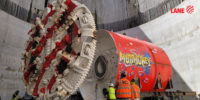The Port of Miami is steaming ahead on the Southeast's largest port project—a $1-billion tunnel aimed at enhancing the South Florida transportation hub's efficiency and interstate connectivity in time for an expected surge in oversized cargo traffic coming from an expanded Panama Canal. Inconsistent geological variations—from loose sand to limestone to porous areas in an undefined pattern—make the Port of Miami Tunnel project a “soft-ground” tunnel, creating challenges in design and construction, says the Florida Dept. of Transportation.
“From an engineering aspect, a tunnel [here], because of the geology, is considered challenging even for a seasoned tunnel [builder],” says Isa Nunez, construction program manager in the Miami office of FDOT.
Miami Access Tunnel (MAT), a partnership between Bouygues Travaux Publics of France and Meridiam Infrastructure, Luxembourg, is funding the start of construction through its $1-billion design-build-finance-operate-maintain contract with FDOT.
Plans call for twin, 4,200-ft-long tunnels below Miami's Government Cut shipping channel. The 43-ft-dia tunnels will connect the port on Dodge Island with nearby Interstate 395 via the MacArthur Causeway, improving port traffic flow.
The tunnel—estimated to be the largest soft-ground tunnel in the U.S.—will run approximately 120 ft under the channel at the deepest point.
Crews are beginning to reassemble the approximately 380-ft-long tunnel boring machine, newly arrived from Schwanau, Germany, in advance of an expected start of boring in October. The $45-million TBM, custom engineered and fabricated by Herrenknecht, will bore for 20 hours, followed by four hours of maintenance, six days a week.
MAT officials estimate that both eastbound and westbound tunneling will take about seven months, with disassembly and reassembly of the TBM in between adding another three months to the schedule.
Readying to Launch
FDOT and MAT's design-build firm, Bouygues Civil Works Florida, a subsidiary of Bouygues Travaux Publics, have conducted geotechnical investigations and are still identifying the best way to handle the inconsistent variations in the geologic layers, says Rick Wilson, MAT's chief operating officer and technical manager.
“The geological conditions contain a large amount of water due to the overall ground porosity,” says Bernard Catalano, Bouygues' lead TBM engineer. “While it is soft rock—as opposed to granite, where you have to push with great force but there is little water—this tunnel is quite dense with water, and therefore the TBM must push with more force in order to counteract the pressure produced by the water in the soft rock.”




Post a comment to this article
Report Abusive Comment